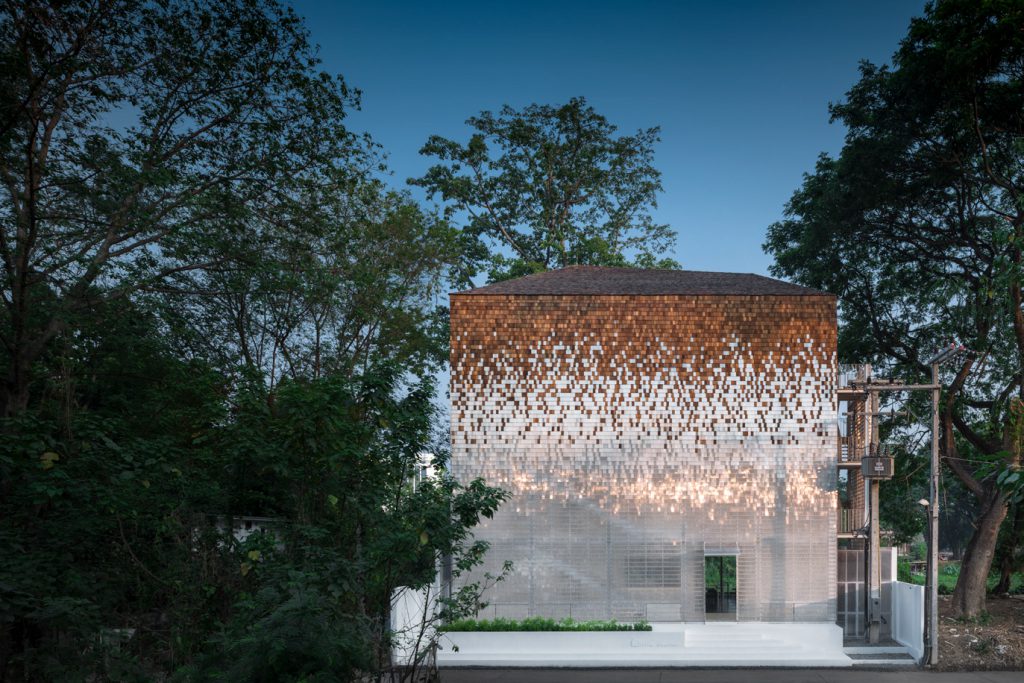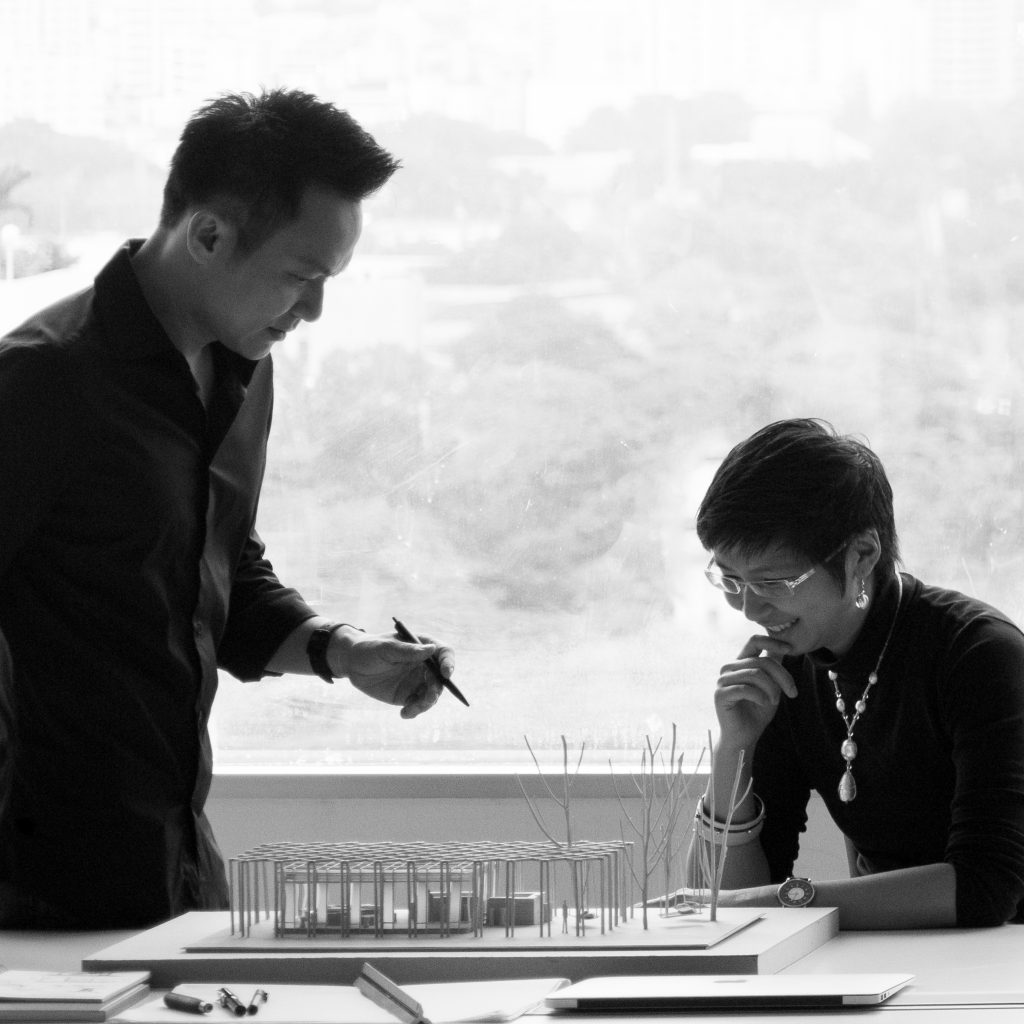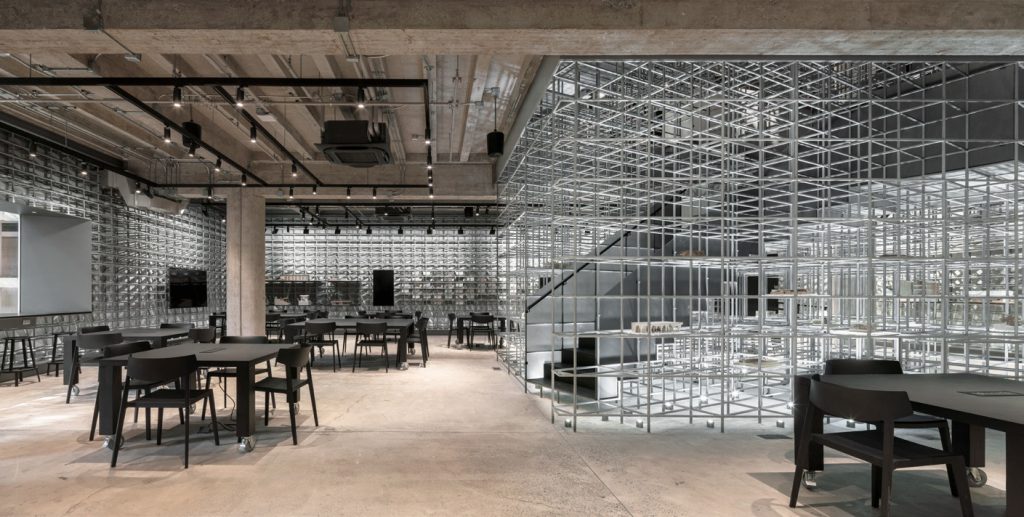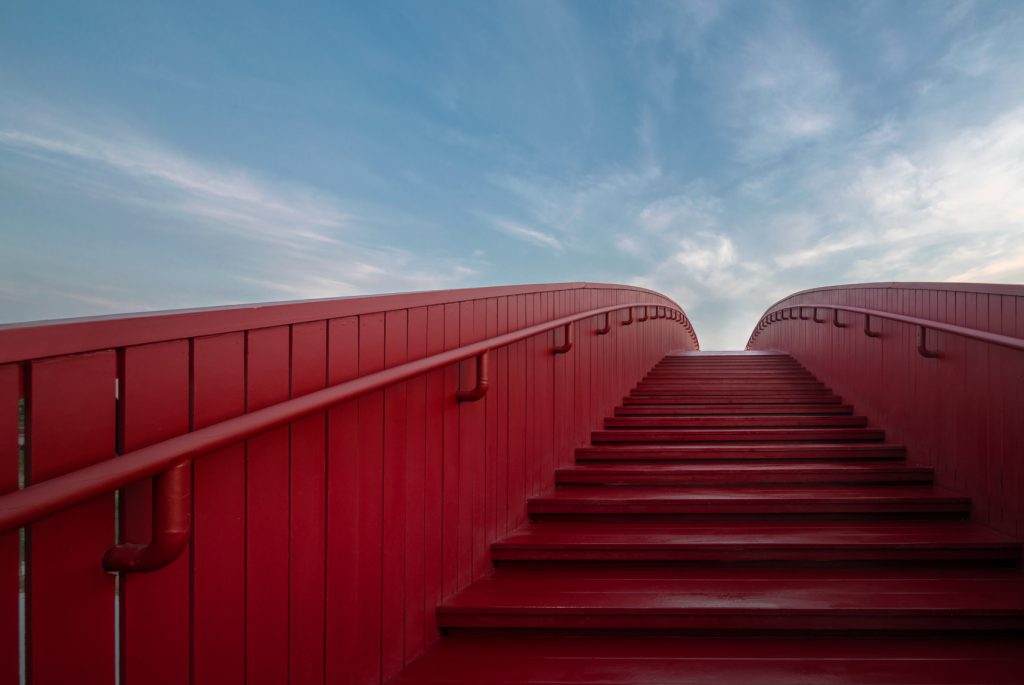‘Department of Architecture’ is an internationally recognized Thai architecture firm with projects and credentials that attest to its indisputable brilliance. The following conversation with Amata Luphaiboon and Twitee Vajrabhaya Teparkum, the firm’s two founders and principals, vividly depicts their ideologies, backgrounds, and characters, out of which the Department of Architecture is created.
Text: Nuttawadee Suttanan

“Department of Architecture” คือบริษัทสถาปนิกของไทยที่ได้รับการยอมรับในระดับโลก ด้วยผลงานและรางวัลมากมาย ล้วนเป็นเครื่องการันตีความสามารถของ Department of Architecture ได้อย่างชัดเจน และทุกบทสนทนาที่เกิดขึ้นระหว่างการพูดคุยกับ “บี-อมตะ หลูไพบูลย์” และ “ตี้-ทวิตีย์ วัชราภัย เทพาคำ” สองผู้ก่อตั้ง ล้วนสะท้อนให้เห็นถึงวิธีคิด เบื้องหลัง และตัวตน ที่ประกอบสร้างขึ้นมาเป็น Department of Architecture ได้เป็นอย่างดี
“ตกตะกอน และ ก่อผลึก”
“Department of Architecture” ร่วมก่อตั้งโดย “บี-อมตะ หลูไพบูลย์” และ “ตี้-ทวิตีย์ วัชราภัย เทพาคำ” รุ่นพี่รุ่นน้องจากคณะสถาปัตยกรรมศาสตร์ จุฬาลงกรณ์มหาวิทยาลัย ในสมัยเรียนทั้งสองคนรู้จักกันผ่านคำบอกเล่า โดยที่ยังไม่เคยเจอกันในมหาวิทยาลัยเลยสักครั้ง จนกระทั่งได้มีโอกาสเป็นเพื่อนร่วมงานที่บริษัท Metric Consulting Engineers & Architects จากรุ่นพี่รุ่นน้องที่ไม่เคยพูดคุยกันสู่สถานะ “เพื่อนร่วมงาน” บีและตี้พบว่าเขาทั้งสองคนมีอุดมการณ์และทิศทางการทำงานคล้ายกันมาก ทุกครั้งที่ได้ทำงานร่วมกัน การพูดคุยและแนวทางการทำงานมักจะสอดคล้องและต่อยอดกันและกันเสมอ
นอกจากการทำงานที่ส่งเสริมกันและกัน ประสบการณ์ที่สั่งสมจากการทำงานมาเป็นระยะเวลาหนึ่ง ได้ตกตะกอนเกิดเป็นการเรียนรู้ที่ทำให้บีและตี้ได้รู้ว่า ทิศทางการทำงานของพวกเขาจะเป็นไปในทิศทางใด จนนำไปสู่การออกมาเปิดบริษัทสถาปนิกร่วมกันในชื่อ “Department of Architecture” โดย บี อมตะ หลูไพบูลย์ เล่าให้ฟังว่า “เราผ่านอะไรมาสักพักหนึ่ง แล้วค่อยมาตั้งบริษัท พอต่างคนต่างมีประสบการณ์ และทำให้เราเริ่มมีทักษะและมีความเชี่ยวชาญ พอที่จะเริ่มโครงการเองได้ตั้งแต่ต้นจนจบ เริ่มรู้จักคนมากขึ้น แล้วก็เริ่มรู้ว่าเราจะเป็นสถาปนิกแบบไหน เหมือนคล้าย ๆ ว่าเริ่มตกตะกอนแล้ว และเริ่มรู้ตัวว่าจะก่อเป็นผลึกลักษณะไหน”

“พื้นที่ที่เราคิดได้อย่างไม่มีขีดจำกัด”
เมื่อตัดสินใจเปิดบริษัทร่วมกัน บีและตี้เริ่มตั้งแต่ศึกษาแนวทางการตั้งบริษัท จนค้นพบว่าบริษัทสถาปนิกมีหลากหลายแนวทาง ตามความถนัด ความสนใจ ความอยากและความต้องการของผู้ก่อตั้ง “การกำหนดทิศทางบริษัท” จึงเป็นสิ่งสำคัญในการเริ่มทำบริษัท พวกเขามองว่าการกำหนดทิศทางว่าสิ่งที่เราต้องการทำคือสิ่งไหน หรือสิ่งที่เราถนัดคืออะไร จะช่วยทำให้บริษัทของเรามีแนวทางหรือเส้นทางที่จะเดินไปชัดเจนยิ่งขึ้น และสิ่งสำคัญคือการทำทุกอย่างอย่าง “มีสติ”
สำหรับบีและตี้ พวกเขาคิดว่าความถนัดและความอยากของพวกเขา คือ “ความอยากและความสนุกที่จะแสวงหา สำรวจสิ่งใหม่ๆ อยู่ตลอดเวลา” และสิ่งนี้ก็เป็นที่มาของชื่อ “Department of Architecture” บริษัทสถาปนิกที่มีชื่อเหมือนภาควิชาสถาปัตยกรรม เพราะพวกเขาต้องการให้ที่แห่งนี้สะท้อนถึงการสำรวจที่ไม่มีวันสิ้นสุด เหมือนห้องเรียนการออกแบบที่พวกเขาเคยได้เข้าไปเรียนรู้และผ่านมา และให้บริษัทแห่งนี้เป็นเสมือนพื้นที่แห่งการสำรวจ การคิด และการทดลองด้านการออกแบบอย่างไม่มีขีดจำกัด ดังเช่นคำบอกเล่าของ ตี้-ทวิตีย์ “เราสนุกกับการสำรวจ และก็เป็นที่มาของชื่อออฟฟิศ ที่สะท้อนถึงการสำรวจ เหมือนที่แห่งนี้เป็นโรงเรียนสถาปัตยกรรม เพราะตอนที่เราเรียน คือช่วงเวลาที่เราคิดไปได้อย่างไม่มีขีดจำกัด เป็นการทดลอง ก็เลยคิดถึงชื่อภาควิชา Department of Architecture มันเหมือนกับว่านี่คือพื้นที่ที่เราสำรวจสิ่งใหม่ๆ เหมือนกับเรายังเป็นเด็กนักเรียนอยู่่ และนอกจากนี้ คำว่า Department of Architecture ก็มีหลายความหมาย เราเล่นคำกับความหมาย และทำให้ชื่อบริษัทของเราเป็นเรื่องที่ใช้เปิดบทสนทนาได้เป็นอย่างดี”
“แล้วเราก็ค่อยๆ โต”
“Department of Architecture” ก่อตั้งขึ้นเมื่อปีพุทธศักราช 2547 เริ่มต้นด้วยสมาชิกไม่ถึง 10 คน รวมบีและตี้ ก่อนที่บริษัทจะค่อยๆ เติบโต จนมีสมาชิกประมาณ 24 – 25 คน ในปัจจุบัน ประสบการณ์จากการทำงานในบริษัทใหญ่มาก่อน ทำให้ “Department of Architecture” มีระบบการทำงานที่ค่อนข้างชัดเจน แต่ก็ยืดหยุ่นได้ตามสถานการณ์ ด้วยจำนวนสมาชิกของบริษัทที่ยังไม่มากในช่วงแรก สำหรับงานในส่วนที่ไม่ใช่งานออกแบบในระยะแรก เป็นหน้าที่ที่ทุกคนในบริษัทจะต้องช่วยกัน ตั้งแต่ทำใบเสนอราคาไปจนถึงการซ่อมเก้าอี้ จนกระทั่งเมื่อสมาชิกมีจำนวนมากขึ้น บริษัทก็ได้เพิ่มตำแหน่ง “Office Administrator” มาเพื่อช่วยสนับสนุนการทำงานของทุกคนให้สะดวกและคล่องตัวยิ่งขึ้น ส่วนในเรื่องการบริหารจัดการการเงินและบัญชี นับจากเริ่มต้นจนปัจจุบัน บริษัทได้ใช้ผู้เชี่ยวชาญจากภายนอกเป็นผู้ดูแล เช่นเดียวกับหลายบริษัทที่ไม่ได้มีพนักงานบัญชีประจำบริษัท
“พอบริษัทมีคนเยอะขึ้น ตอนนี้เรามีประมาณยี่สิบกว่าคน ก็เท่ากับว่า ณ ขณะหนึ่งๆ เราทั้งสองคนก็จะคุยกับน้อง แบ่งได้ประมาณสิบกว่าคนต้นๆ ต่อคน ซึ่งเป็นอะไรที่คุยได้โดยตรงอยู่ดี จริงๆ คล้ายกับบริษัทเล็กที่มีคนสิบคนแล้วก็มีหัวหน้าคนเดียว”
ในปัจจุบัน นอกจาก office administrator ที่คอยดูแลภาพรวมของบริษัทแล้ว สมาชิกที่เหลือของ Department of Architecture คือ “ทีมออกแบบ” ซึ่งบีและตี้เป็นผู้ดูแลโดยตรง ในช่วงแรกของการก่อตั้งบริษัท พวกเขาจะทำหน้าที่สอนงานน้องใหม่ในทีมเองทุกคน แต่เมื่อจำนวนสมาชิกมีเพิ่มขึ้น บริษัทก็จะมีพนักงานที่มีอาวุโสหรือเข้ามาก่อน เป็นรุ่นพี่คอยสอนงานคนที่เข้ามาใหม่ในส่วนของเทคนิคในการทำงาน การใช้โปรแกรมหรือการจัดการแบบต่าง ๆ แต่ถึงอย่างไรในเรื่องการออกแบบหรือรายละเอียดการทำงานในเชิงลึก สมาชิกทุกคนของ Department of Architecture ก็จะได้ทำงานร่วมกันและคุยงานโดยตรงกับบีและตี้
“ทีมออกแบบ” ของ Department of Architecture ไม่ได้มีการแบ่งอย่างชัดเจนว่าเป็นทีมสถาปนิกหรือทีมมัณฑนากร หรือแบ่งเป็นทีมของบีหรือตี้ พวกเขาตั้งใจจะให้สมาชิกทุกคนมีโอกาสได้เรียนรู้และทำงานร่วมกัน โดยที่น้ำหนักของงานอาจจะเป็นการทำในสิ่งที่ตนเองถนัด และเปิดโอกาสให้ได้ทำงานในสิ่งที่ไม่ถนัด เพื่อได้เรียนรู้และเพิ่มทักษะให้กับทุกคนในทีม สอดคล้องกับที่พวกเขาวางทิศทางให้บริษัทแห่งนี้เป็นห้องเรียนที่ทุกคนได้สำรวจ ทดลอง เรียนรู้ ร่วมกันนั่นเอง สำหรับ บี อมตะ เขามองว่า “น้องๆที่จบออกแบบสถาปัตยกรรมภายในจะได้ทำงานสถาปัตยกรรม แล้วก็น้องสถาปนิกก็จะได้ทำงานออกแบบสถาปัตยกรรมภายในด้วย มีโอกาสสลับกันอยู่ตลอดเวลา ไม่ได้มีขอบเขตชัดเจนว่าต้องทำอย่างใดอย่างหนึ่งเท่านั้น คือทำงานร่วมกัน หรือช่วยกัน แต่น้ำหนักงานก็จะไปในทางที่ตัวเองถนัดก่อน”

ขั้นตอนการทำงานออกแบบตามแบบฉบับ Department of Architecture เริ่มเมื่อมีคนติดต่องานเข้ามา บีกับตี้จะคุยกันตั้งแต่ลักษะของงาน เวลา ความสนใจ ขนาด เพื่อปรึกษากันว่าบริษัทจะรับงานนี้หรือไม่ ขั้นตอนถัดไปคือการจัดการเรื่องของงบประมาณและเวลาในการทำงาน และเมื่อตกลงเริ่มงาน บีและตี้จะเป็นผู้วางทิศทางการทำงานในภาพรวม ก่อนจะมอบหมายงานในส่วนต่างๆ ให้แก่สมาชิกในทีม และสมาชิกทุกคนจะได้ร่วมกันสำรวจ ทดลอง หรือค้นหาแนวทางในการทำงานร่วมกัน ถ้าเป็นงานขนาดเล็ก บีและตี้ก็อาจจะแยกกันทำงาน และมีช่วงที่ปรึกษากันเป็นระยะ แต่ถ้าเป็นงานขนาดใหญ่ บางครั้งทั้งสองคนก็จะดูแลโครงการนั้นร่วมกัน โดยการทำงานโครงการใหญ่มักจะเริ่มต้นด้วยทีมขนาดเล็ก ก่อนที่จะค่อยๆ เสริมสมาชิกในทีมเข้ามาตามเนื้องาน และสมาชิกทุกคนจะได้ทำงานกับบีและตี้โดยตรงตลอดทั้งโครงการ
หัวใจสำคัญของการทำงานแบบ Department of Architecture ในหลายๆ งาน โดยเฉพาะงานขนาดกลางหรืองานขนาดเล็ก คือการส่ง Conceptual Design พร้อมกันทั้งงานสถาปัตยกรรมและงานออกแบบภายใน พวกเขาไม่สามารถแยกหรือห้ามความคิดให้ดูเพียงแค่สถาปัตยกรรมหรือการตกแต่งภายในอย่างใดอย่างหนึ่งได้ เพราะพวกเขาเห็นว่าทั้งสองอย่าง “คือสิ่งเดียวกัน”
“การทำงานที่มีความสุข”
บีและตี้ ตั้งใจให้สมาชิกของ Department of Architecture ทำงานอย่างมีความสุข ผู้ที่จะเข้ามาเป็นส่วนหนึ่งของที่แห่งนี้จึงถูกคัดสรรมาตั้งแต่การส่งใบสมัครและผลงาน เพื่อหาคนที่เหมาะกับบริษัทมากที่สุด
ทั้งแนวทางการทำงาน ทัศนคติ ทักษะ และรสนิยม นอกจากการดูจากใบสมัคร การสัมภาษณ์ทุกคนด้วยตนเองก็เป็นอีกอย่างหนึ่งที่จะทำให้ได้คนที่มีเหมาะกับบริษัทนี้ เพราะการทำงานออกแบบนั้นมีความหลากหลายและแตกต่าง พวกเขาเชื่อว่าการได้ทำงานร่วมกันกับคนที่มีแนวทางเดียวกัน ก็จะทำให้การทำงานเต็มไปด้วยความสุข
การมีความสุขในการทำงานสำหรับบีและตี้ คือการทำงานที่ไม่หนักเกินไป หรือหนักในช่วงที่กำลังดี
เพราะพวกเขารู้ว่าวิชาชีพสถาปนิกหรือนักออกแบบ ต้องพบเจอกับช่วงเวลาที่ต้องทำงานหนักอยู่เสมอ แต่อย่างน้อย พวกเขาก็อยากให้การทำงานหนักที่นี่เป็นการทำงานหนักที่มีความสุข บีและตี้จึงตั้งใจรับงานที่พวกเขาสนใจและคิดว่าสมาชิกในบริษัทจะสนใจ เพราะการได้งานที่น่าสนใจ มีความตื่นเต้นในการทำงานอยู่เสมอ ได้สำรวจ ค้นพบ หรือทดลองสิ่งใหม่ๆ อยู่เสมอ เป็นสิ่งสำคัญที่ทำให้สมาชิกในทีมสนุกกับแต่ละขั้นตอนในการทำงาน และเป็นสิ่งที่ทำให้ผู้ร่วมงานอยากทำงานร่วมกับเราไปนานๆ เช่นกัน
นอกจากนี้ กิจกรรมประจำปีอย่างการท่องเที่ยวประจำปีหรือกิจกรรมปีใหม่ของบริษัท ก็เป็นอีกกิจกรรมหนึ่งที่พวกเขาตั้งใจให้ทุกคนในบริษัทได้มีช่วงเวลาที่ผ่อนคลายร่วมกัน หลังจากการทำงานหนักตลอดทั้งปี เพราะสำหรับ ตี้ ทวิตีย์ แล้วมองว่า “น้องๆ เราน่ารักหมดทุกคนเลย แล้วก็เราเองพยายามที่จะให้น้องเขาทำงานอย่างมีความสุขไปกับเรา เราอยากให้น้องทำงานอย่างมีความสุข การมีความสุขคือทำงานไม่หนักเกินไป ถึงจะทำงานหนัก แต่ก็อยากให้การทำงานหนักของเขา อย่างน้อยก็เป็นการทำงานหนักที่มีความสุข”
สถานการณ์โรคระบาดโควิด-19 เป็นอีกเหตุการณ์ที่สร้างการเปลี่ยนแปลงให้แก่ระบบการทำงานของ Department of Architecture และจากความตั้งใจของบีและตี้ที่อยากให้สมาชิกทุกคนมีความสุขในการทำงาน พวกเขาจึงปรับการทำงานโดยให้สมาชิกทุกคนสามารถเลือกได้ว่าจะทำงานที่บริษัทหรือที่บ้าน อาจจะมีการนัดหมายหรือนัดเจอกันเป็นระยะตามสถานการณ์หรือเนื้องาน และสิ่งที่สะท้อนกลับมาคือสมาชิกในทีมได้ใช้เวลากับครอบครัว กับกิจกรรม หรือกับสุขภาพของเขาเองได้มากขึ้น ที่สำคัญคือทุกคนต่างมีเวลาในชีวิตมากขึ้น

“เพราะว่าเขาต้องการสิ่งที่พิเศษ”
ปัจจุบัน Department of Architecture คือหนึ่งในบริษัทสถาปนิกไทยที่ก้าวขึ้นไปยืนบนเวทีโลกอย่างสง่างาม ผลงานมากมายของพวกเขาไม่ได้จำกัดอยู่เพียงในประเทศไทยเท่านั้น แต่กว่าครึ่งหนึ่งคืองานที่ได้สร้างและมีชื่อเสียงอยู่ต่างประเทศ จุดเริ่มต้นการทำงานกับต่างประเทศของ Department of Architecture เริ่มจากการที่ผลงานของพวกเขาได้ไปปรากฎในดีไซน์เว็บไซต์ต่างๆ ที่มีอยู่มากมาย จนเกิดเป็นความสนใจในผลงานและเกิดเป็นโอกาสในการทำงานที่ต่างประเทศ แม้ขั้นตอนการทำงานในต่างประเทศจะแทบไม่ต่างกับการทำงานออกแบบในไทย แต่สิ่งหนึ่งที่เห็นได้ชัด คือ ความเคารพในผู้ออกแบบ และความต้องการผลงานการออกแบบที่ “พิเศษ” จากเราที่สะท้อนผ่านความพยายามในการทำงานร่วมกันแม้จะสื่อสารกันคนละภาษาก็ตาม
กว่าครึ่งหนึ่งของลูกค้าของ Department of Architecture คือจากประเทศจีน ทำให้บริษัทมีตำแหน่ง Project coordinator ซึ่งเป็นชาวจีนที่ทำงานประจำอยู่ที่บริษัท ช่วยทำให้การติดต่อการก่อสร้างต่าง ๆ ในประเทศจีนคล่องตัวมากขึ้น ส่วนในประเทศอื่นๆ ที่ใช้การสื่อสารภาษาอังกฤษได้ บีและตี้จะทำหน้าที่ประสานหลักเช่นเดิม เหมือนระยะแรกที่เริ่มรับงานจากต่างประเทศ สำหรับการไปดูหน้างานในต่างประเทศ บีและตี้จะเป็นผู้เดินทางไปด้วยตนเอง มีเพียงส่วนน้อย เช่น การเดินทางไปเพื่อดูเฉพาะเรื่อง หรือไปทำงานร่วมกับวิศวะในบางประเด็น ที่จะส่งรุ่นพี่ในบริษัทไปแทน
แม้สถานการณ์โควิด-19 จะทำให้เกิดผลกระทบกับการทำงานในช่วงแรก แต่ก็ไม่ได้ทำให้การทำงานสะดุดไปนานนัก การคุยงานออนไลน์กับลูกค้าต่างประเทศมาก่อนช่วยให้การทำงานในสถานการณ์โควิด-19 สะดวกยิ่งขึ้น แต่สิ่งหนึ่งที่เห็นได้ชัดจากสถานการณ์นี้ คือช่องทางการทำงานกับต่างประเทศที่หลากหลายมากขึ้น จากแต่เดิมที่ต้องเดินทางไปประชุมหรือนำเสนองานถึงต่างประเทศ ก็มีการปรับเปลี่ยนตามสถานการณ์ เมื่อการทำงานบนโลกออนไลน์เริ่มมีบทบาทมากขึ้นในช่วงโควิด

“บรรยากาศตอนนี้ดีอย่างน่าตื่นเต้น”
เราปิดท้ายการพูดคุยถึงมุมมองต่อวงการสถาปนิกไทยในปัจจุบันของบีและตี้ สิ่งหนึ่งที่พวกเขาตอบเหมือนกันคือ ในวันนี้ วงการสถาปนิกมี “บรรยากาศที่ดีอย่างน่าตื่นเต้น” สิ่งเหล่านี้ถูกสะท้อนผ่านผลงานดีๆของสถาปนิกในทุกรุ่น ตั้งแต่รุ่นใหม่ไปจนถึงรุ่นใหญ่ และเกิดบริษัทสถาปนิกที่มีงานที่น่าสนใจมากมาย รวมทั้งทำให้คนในวงกว้างได้เห็นงานที่น่าสนใจในรูปแบบที่หลากหลายอยู่เสมอ พวกเขาให้คำนิยามว่านี่คือบรรยากาศแห่งความหวัง เพราะนอกจากวงการสถาปนิกจะมีนักออกแบบฝีมือดีเพิ่มขึ้นมากมาย แต่คนทั่วไปก็เริ่มให้ความสนใจกับงานออกแบบมากขึ้น ให้คุณค่ากับงานออกแบบเยอะขึ้น และเริ่มมีความต้องการสร้างผลงานโดยใช้การออกแบบเข้ามามีส่วนประกอบมากขึ้น ไม่ว่าจะเป็นงานขนาดเล็กหรือใหญ่ก็ตาม
โดยในความเห็นของ บี อมตะ เขามองว่า “เรามีสถาปนิกทีทำงานดีๆ อยู่ในทุกภูมิภาค แล้วทำงานเป็นที่น่าชื่นชนในระดับที่ต่างประเทศให้ความสนใจเยอะมาก และผมเชื่อว่าสิ่งนี้เป็นแรงบันดาลใจให้น้อง ๆ คือเด็กที่กำลังเรียนอยู่หรือที่พึ่งจบได้เลยว่า คนทั่วไปเขาสนใจงานออกแบบ ถ้าเราทำงานออกแบบดีๆ ออกไป จะได้รับการชื่นชมและสนใจในวงกว้าง บรรยากาศตอนนี้ดีอย่างน่าตื่นเต้น”
ในขณะที่ ตี้ ทวิตีย์ เองช่วยเสริม “ตอนนี้มีความหวังสุดๆ เลย คือมีงานที่น่าสนใจออกมาเยอะมาก ตั้งแต่รุ่นเล็กๆ ไปจนถึงรุ่นใหญ่ๆ ที่คิดว่าบรรยากาศมันดีมาก ๆ อาจเป็นเพราะว่าคนทั่วไปให้ความสนใจกับงานออกแบบเยอะ เพราะฉะนั้นก็มีความต้องการ คือเราคิดว่าก่อนหน้านี้ไม่ใช่ว่าสถาปนิกไม่เก่ง แต่ว่าโอกาสน้อยกว่า อาจจะเป็นเพราะเมื่อก่อนเราอยู่ในยุคที่คนทั่วไปจำนวนหนึ่งอยากได้สิ่งก่อสร้างเอาไว้ใช้สอยเฉย ๆ แต่ว่าหลังๆ มานี้คนต้องการการออกแบบพอคนต้องการ และนักออกแบบเราก็พร้อมที่จะทำ ก็เลยออกพอดีกัน”
“ทางที่เรายังเดินทางต่อไปได้อีกยาวไกล”
นับจากวันแรกของการก่อตั้งบริษัทจนถึงวันนี้ ปัจจุบัน Department of Architecture เดินทางมาเป็นระยะเวลากว่า 18 ปี ในวันที่เริ่มต้น ทั้งบีและตี้ไม่เคยคาดคิดว่าจะมีจำนวนสมาชิกเกือบสามสิบคนอย่างเช่นในทุกวันนี้ แต่พวกเขาก็คิดว่าด้วยขนาดของบริษัทในตอนนี้ กำลังพอดีกับการบริหารจัดการโดยพวกเขาเพียงสองคน
18 ปีที่ผ่านมา แม้พวกเขาจะได้ทำงานในรูปแบบต่างๆ ที่หลากหลาย แต่พวกเขาก็พร้อมและตั้งใจที่จะสำรวจและเข้าไปเรียนรู้งานออกแบบในรูปแบบใหม่ๆ อย่างไม่มีวันสิ้นสุด หากถามว่า 18 ปีที่ผ่านมา พวกเขาเดินทางมาได้เหมือนอย่างที่คิดไว้หรือไม่ คำตอบที่บีและตี้ให้กับเราคือ พวกเขามาได้มากกว่าที่คิด และรู้ว่ายังมีทางที่สามารถเดินต่อไปได้อีกยาวไกล ทางที่พวกเขากำลังเดินอยู่อาจจะเป็นพึ่งมาถึงแค่ครึ่งทาง และเส้นทางที่เหลือก็ช่างตื่นเต้นไม่ต่างกับทางที่เดินมา

(right) Twitee Vajrabhaya Teparkum
“Department of Architecture” is an internationally recognized Thai architecture firm with projects and credentials that attest to its indisputable brilliance. The following conversation with Amata Luphaiboon and Twitee Vajrabhaya Teparkum, the firm’s two founders and principals, vividly depicts their ideologies, backgrounds, and characters, out of which the Department of Architecture is created.
“Settled and Crystalized”
Twitee Vajrabhaya Teparkum and Amata Luphaiboon co-founded the Department of Architecture. They were both students at Chulalongkorn University’s Faculty of Architecture, with Amata being the senior, and were introduced to one another through random conversations with mutual acquaintances. Prior to becoming coworkers at Metric Consulting Engineers & Architects, they never actually crossed paths on campus. Amata and Twitee, who were college seniors and juniors who had never spoken before becoming “co-workers,” discovered that they had a very similar architectural ideology and trajectory. Whenever they collaborated on a given assignment, their discussions and decisions frequently mirrored and complemented one another.
In addition to the flow and rhythm they had formed as coworkers, the two were beginning to crystallize the experiences they had gained over time as they determined the course of their work and careers. It ultimately led to their departure from the company and the establishment of their own architectural practice. Department of Architecture is the name they call themselves.
Amata recounts the early days of the studio, saying, “We worked and accumulated experience for some time before establishing the company together. Both of us have considerable expertise and skills to initiate and execute a project. We were beginning to know more people and knew what kind of architects we wished to become. It was as though our minds were crystalized and we knew how we wanted to grow and what we wanted to become.”

“A place with boundless ideas”
Amata and Twitee, having decided to build a studio together, began by examining the approaches they would take as a company. They discovered that architectural firms are run based on a variety of approaches, interests, and expertise, as well as the founders’ personal aspirations. “Determining the company’s trajectory” was an essential stage in launching their firm.
In their view, starting off with a clear vision of what they intended to accomplish, while keeping in mind that their strength and expertise would help them establish an even clearer vision as the firm evolved. They also agree that another important thing was to be “mindful” of everything they were going do.
The drive and expertise of both Amata and Twitee lie in their “passion and desire to continually discover new things.” Such a standpoint also explains the genesis of the name “Department of Architecture.” They wanted to name of the professional architecture firm they created together which connotes a place where the founders learned their craft. The name reflects the founders’ desire for their organization to be a place of endless discovery; a design classroom they once attended. As Twitee states, they want the organization to be a space where design-related discovery, ideation, and experimentation can flourish without limitation.
“We’ve always loved exploring, and that became the inspiration behind the name of our office. It embodies this spirit of exploration. Because while we were students, our ideas were unrestricted and we were able to experiment with anything imaginable, we want this space to resemble a school of architecture.
We associate the word Department of Architecture with a place where we can continue to learn new things, just as we did as students. Additionally, the name “Department of Architecture” contains numerous connotations and nuances. We wish to explore these potential connotations and let the moniker spark new conversations.”
“And then we grow”
When Department of Architecture was formed in 2004, it had less than 10 employees, including Amata and Twitee. The company has seen a steady and progressive growth and today employs 24 -25 people. With the experience of its two founders working in large corporations, Department of Architecture has built a highly ordered yet adaptable working system, especially in its early days when the number of employees was relatively modest. In the beginning, staff members were responsible for all administrative and document-related tasks, from creating quotations to repairing broken chairs.
As the team expanded, the company employed an office administrator to improve the flow of work and increase convenience for other team members. The finance and accounting-related issues have always been handled by an outsourced specialist, similar to a majority of businesses who do not employ an in-house accountant. “Even though we have a larger crew, twenty or so people, each of us can still personally supervise ten staff members, so it’s almost as if we each run a small studio with ten employees.”
Except for the office administrator who oversees the company’s overall operations, the remaining Department of Architecture employees are all members of the “design team,” which is directly supervised by Amata and Twitee. In the early days of the company, the two partners trained all new hires themselves. However, now that they have more staff, the responsibility has been delegated to the senior staff members, who instruct the junior employees on all work-related skills, how to work with programs and manage the working drawings.
However, when it comes to design and intricate details, all members of the Department of Architecture’s design team will collaborate and consult directly with Amata and Twitee on each project. The design team is not separated into architectural and interior design teams or Amata and Twittee teams, etc. This is because the two principals want every member to undergo the same learning and collaboration process. The tasks are prioritized depending on each staff member’s expertise, but everyone is given the opportunity to do something they may not be very good at in order to learn and grow. It’s an approach that reflects the company’s direction and desire to be a learning environment where everyone can explore and discover together.
According to Amata, “the staff with a background in interior architecture will work on architectural design, while the people with a background in architectural design will also get to work on interior design. The roles are interchangeable at all times. We do not clearly delineate who is responsible for what. Everyone collaborates and assists one another, although the majority of their tasks are focused on their areas of competence.”

The work process of Department of Architecture begins when a client contacts the firm about a project. Amata and Twitee will explore the nature and scope of the work, and whether they’re interested in working on it or not. The following phase entails establishing a budget and timeline. Once the decision to undertake a project has been made, Amata and Twitee will outline the project’s overall direction before assigning staff members’ specific responsibilities. As a collaborative effort, the team will explore, experiment, or navigate collectively. Amata and Twitee may work separately on a small-scale project, although they may periodically confer with one another. If the project is large, the two founders will supervise it together.
Typically, a small team begins working on a large project before more individuals are added to meet the additional responsibilities. Each team member will have the opportunity to collaborate directly with Amata and Twitee throughout the duration of the process. Submitting the conceptual design, architectural design, and interior design simultaneously is crucial to the Department of Architecture’s operation, particularly for projects of medium to small scale. The method is developed from the fact that they cannot think of architecture and interior design as separate components, because they view the two as a whole entity.
‘Working Happily’
Amata and Twitee intend for the staff members of Department of Architecture to work happily. The employees who will join the company are chosen based on their portfolio and cover letter. The two founders want a candidate who will suit their team based on their work ethic, attitude, talents, and preferences. Both Amata and Twitee personally review each application and interview each applicant. It is one of the reasons why they have been able to assemble a team of individuals who complement the vision and direction of their practice. Due to the nature of design, which centers around originality and diversity, they believe that working with individuals who share a similar attitude and perspective will make the overall working experience enjoyable.
For Amata and Twitee, being happy with their job entails working hard, but not too hard and for a reasonable cause and time. They are aware that architects and designers, by their very nature, are a profession that works long hours. But at Department of Architecture, they hope that even though their team may work hard, it is the kind of hard work that makes them happy. One of Amata and Twitee’s goals for the company is to focus on projects that they and their team members are passionate about. They are aware that being able to work on something that interests you makes work more rewarding. This type of project allows them to explore, learn, and experiment with new things, which greatly contributes to the happiness and satisfaction of their employees.
A positive work atmosphere will encourage employees to stay with the company for a long time. An annual trip or New Year’s party are among the activities intended to provide everyone with time to unwind outside of work after an intense year. “We have an incredible crew. Everyone is extraordinary, and we want them to enjoy working for us. We want them to take pleasure in their work. By happiness, I mean that they shouldn’t have to work too hard, or if they do, we want it to be a pleasurable and worthwhile experience.”
The COVID-19 pandemic is among the events that affected the Department of Architecture’s operations. In an effort to make their employees happy, the partners have embraced a new work technique that allows them to work from home or the office. They continue to hold scheduled meetings so everyone may catch up and receive project updates. This new method allows staff members to spend more time with their families and loved ones, engage in activities of personal interest, and focus more on their health. Overall, everyone’s work-life balance has improved dramatically.
“Because they all want something special”
Department of Architecture is one of Thailand’s preeminent architectural firms with a well-deserved reputation in the international design community. Their diverse and extensive portfolios include projects outside of Thailand. It is safe to say that more than half of their portfolio consists of internationally recognized, overseas projects. The beginning of their international route began when their works were starting to be featured on design websites. It led to clients from overseas to become increasingly interested in their work before they were eventually able to acquire one. While the work process of their overseas projects is nearly identical to the projects they have done in Thailand, one thing they have learned from their international clients is their respect for them as designers. This group of clients desires to see something “special,” which is reflected in the collaborative work process between the design team and a client despite the language barrier.
More than half of their international clients are Chinese, which explains why the company has hired an in-house Chinese project coordinator whose duty is to facilitate communication and the construction process for their projects in China. With projects where English may serve as the primary language, Amata and Twitee are the main coordinators, as they did in the firm’s early days when it began to attract international clientele. As for international site inspection, Amata and Twitee typically travel. On rare occasions, when more detailed concerns need to be examined or an engineer consultation is necessary, senior staff members will be asked to attend.
Even though the pandemic initially affected the company’s operations, they did not face a lengthy period of downtime. They have been conducting online meetings with international clients long before the COVID-19 outbreak, and it has greatly aided their operations at this difficult time. However, one of the most evident lessons they have learnt from such a difficult period is that they have access to a wider variety of other channels. In the midst of the travel ban, the requirement to travel abroad for a meeting or presentation needed to be adapted to online platforms.

“The vibe is great and exciting”
We concluded our conversation by asking Amata and Twitee their views on the Thai architectural industry. They agree that the industry is experiencing an amazing and exciting time. It is evident in the remarkable works produced by architects of all ages, from the young to the seasoned. Emerging architecture firms have an excellent portfolio of projects. Quality, quantity, and variety of works are being exposed to and acknowledged by a far larger audience. They characterize the time as one of hope. The industry is not only attracting increasingly talented architects and designers, but public interest is also growing. People place a higher importance on design than ever before, and there is a growing desire for design to be integrated into many parts of projects of all sizes.
“There are so many excellent architects working in every corner of the country, and many of them have developed works that are internationally respected and admired. I believe that this will serve as a source of inspiration for the younger generation who are studying to become architects and designers, or the recent graduates who are about to embark on a career in this field. If you are able to create great works, they will be appreciated and admired by a much larger group of people,” Amata shares his view.
Twitee agreed and added, “I am now extremely hopeful. Younger generation architects and veteran firms are producing an abundance of remarkable projects. The vibe is great and exciting. Possibly since people’s interest in design is increasing, there are now more demands. It’s not that I don’t believe Thai architects before to this era were talented, but there were fewer opportunities back then. Perhaps this is because we used to work during a time when people believed that buildings were made purely for utilitarian purposes. But people’s demands and expectations in design have increased, and our architects and designers are prepared to meet them.”
“A long way ahead”
Since its establishment 18 years ago, Department of Architecture is still thriving in its journey. When they first began, neither Amata nor Twitee could have predicted that the company they co-founded would eventually employ nearly thirty people. Both architects agree that the size of the firm toady is just about right for the two of them to efficeintly supervise.
In the last 18 years, Amata and Twitee have been assigned to work on projects of various styles and natures, but they have remained eager and driven to explore and understand new design possibilities for as long as they can. When asked if the past 18 years had been what they had anticipated, Amata and Twitee said that they have well exceeded their expectations and that there’s still a long way ahead waiting to be explored and discovered. The path they have traveled may only be halfway complete, and the remainder of the journey will be equally interesting.

อ่านบทความคอลัมน์อื่นๆ หรือดาวน์โหลดเล่มวารสารฉบับออนไลน์ 09 Metal Attraction คลิกได้ที่นี่



